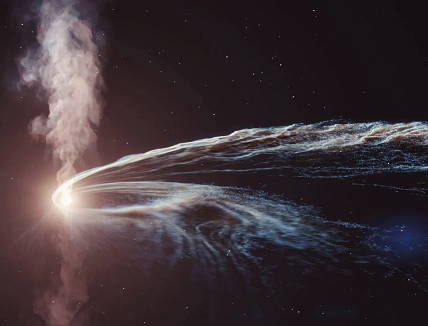
A Black Hole Burping observed by the Scientists, but this was something unexpected as the Black Hole Burp up a shredded star it consumed years ago
An unexpected phenomenon took place in the space which has raised many questions. Yes, this is the Black Hole Burping up a shredded star. Scientists caught a Black Hole violently rips apart and burp up a star that it has consumed three years ago in 2018. According to Astronomers, this phenomenon of burping a star that had been consumed years ago is a rare and new phenomenon. Let us find out in the article about this Black Hole Burping event, but before that have a look into, What a Black Hole is.
What is a Black Hole?
A black hole is a place in the Space where the gravitational pull is so much that even a light cannot come out of it. As light cannot get out of the Black Hole, they are invisible and people cannot see them. These astronomical objects in the universe possess a strong amount of gravity because of the matter squeezed into the tiny space under it, trapping the dead star light.
These ravenous objects swallow up everything that comes close to it even the light itself. They have a very high temperature that made them impossible to observe directly. Special instruments and Telescopes can help in finding the black holes.

Credits: NASA/CXC/M.Weiss
Types of Black Holes in Space
Based on their mass and sizes, Black Holes are classified into three categories:
- Primordial Black Holes: These are the smallest black holes similar to the size of a single atom but have the mass of a large mountain.
- Stellar Black Holes: These are the medium – sized and most commonly found black holes having a mass of 20 times greater than the mass of the sun. Dozens of these Stellar Black Holes may exist within our Milky Way galaxy.
- Supermassive Black Holes: Largest black holes with masses greater than 1 million suns combined together. As per the scientific evidence, at the center of every large galaxy, there is one supermassive black hole. Sagittarius A is the supermassive black hole that is in the heart or center of our Milky Way galaxy.
Stephen Hawking, Black Holes: The Reith Lectures quote; “In space, no one can hear you scream; and in a black hole, no one can see you disappear.”
What is Black Hole Burping?
Black Hole Burping is a very rare phenomenon which is expelling the gas outward. The black holes eat the stars or objects that get close to them and in this process, they sometimes burp up their meal (expel the gas outward in space that shows up with the lighting event). But this time something unexpected happened as a Black Hole Burping the shredded star which it has consumed or eaten three years ago, which is such a long time.

Credit: DESY, Science Communication Lab
In the year 2018, a star that was one-tenth the mass of the Sun, swallowed by a black hole located 665 million light years away. This was a normal event for astronomers and as the month passes away this light show faded in the space. But in the year 2021, the black hole started giving the radio signals and now burped up the star it has eaten years ago in 2018.
Why this Black Hole Burping is unexpected event
This Black Hole Burping was unexpected because black holes usually expel the gases or outflow the material in days or weeks after swallowing up the object. But this time this outflow is delayed by several years and this is the major concern, what caused this delay.
Yvette Cendes, a Research Associate at the Center for Astrophysics | Harvard & Smithsonian (CfA) and lead Author of a new study analyzing the phenomenon said, “This caught us completely by surprise — no one has ever seen anything like this before,” Cendes explains, “We applied for Director’s Discretionary Time on multiple telescopes, which is when you find something so unexpected, you can’t wait for the normal cycle of telescope proposals to observe it. All the applications were immediately accepted.”


















